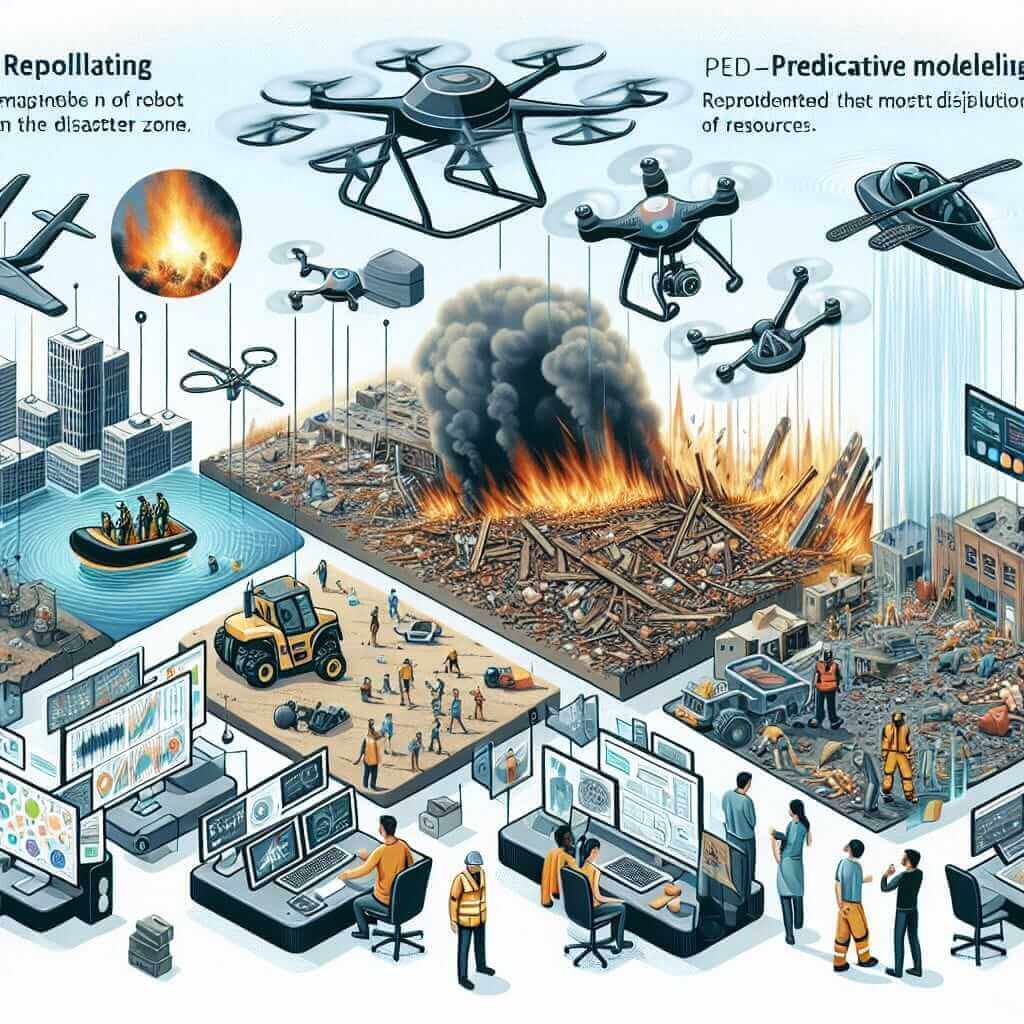In the IELTS Reading section, where comprehension and analytical skills are tested, topics related to technology and disaster management have gained popularity. One such standout topic is “How is AI being used in disaster prediction and response?” Understanding how artificial intelligence (AI) is transforming disaster management is both timely and insightful, given the increasing frequency of natural calamities. In this article, we delve into this subject while providing a carefully crafted practice reading passage for your IELTS preparation.
Full IELTS Reading Passage and Practice Questions
Reading Passage
Artificial Intelligence (AI) has considerably advanced the field of disaster prediction and response by enhancing early warning systems, facilitating efficient resource allocation, and improving real-time decision-making. These innovations contribute to minimizing the impact of natural disasters such as earthquakes, hurricanes, floods, and wildfires.
AI applications in disaster management are diverse. AI algorithms analyze vast amounts of data from satellite images, social media, and other sources to predict the likelihood and severity of impending disasters. For instance, machine learning models can detect patterns in seismic data that precede earthquakes. Similarly, AI predictive models help meteorologists forecast hurricanes with greater precision.

During and after disasters, AI plays a critical role in coordinating response efforts. AI-powered drones can survey affected areas, providing rescuers with real-time visuals, thus enabling rapid and targeted interventions. Additionally, AI chatbots and virtual assistants disseminate crucial information to the public, guiding them to safe zones and updating them on relief efforts.
Moreover, AI-driven logistical models optimize the distribution of resources, ensuring that aid reaches the most affected regions swiftly. For example, during the 2019 Amazon forest fires, AI tools helped emergency services prioritize areas needing immediate attention based on real-time data from various sensors and reports.
Despite its benefits, integrating AI into disaster management presents challenges. Data privacy issues, the significant investment for technology infrastructure, and the need for specialized skills are notable barriers. Additionally, the accuracy of AI predictions depends on the quality of data, requiring continuous updates and validation to remain effective.
Questions
Multiple Choice
-
What key advantage does AI provide in disaster management?
a) Reducing financial costs
b) Enhancing early warning systems
c) Increasing public awareness
d) Simplifying evacuation procedures -
Which type of data is mentioned as being analyzed by AI for disaster prediction?
a) Financial data
b) Traffic data
c) Satellite images
d) Medical records
Identifying Information (True/False/Not Given)
- AI can predict earthquakes by analyzing patterns in seismic data.
- AI virtual assistants can only provide information during hurricanes.
Matching Headings
- Match the statements (A-D) with the appropriate paragraph (1-4):
A) The role of AI in resource distribution during disasters
B) Applications of AI in forecasting
C) Challenges faced in implementing AI technology
D) Initial benefits of AI in disaster management
Short-answer Questions
- What role do AI-powered drones play in disaster response?
- Mention one AI tool that helped during the 2019 Amazon forest fires.
Answer Keys and Explanations
Multiple Choice
-
b) Enhancing early warning systems
- Explanation: The passage highlights AI’s role in enhancing early warning systems as one of the key advantages.
-
c) Satellite images
- Explanation: The passage mentions that AI analyzes satellite images, among other data types, to predict disasters.
Identifying Information (True/False/Not Given)
- True
- Explanation: The passage states that AI models can detect patterns in seismic data that precede earthquakes.
- False
- Explanation: The passage mentions that AI chatbots and virtual assistants provide information during and after various disasters, not only hurricanes.
Matching Headings
- 1-D) Initial benefits of AI in disaster management
2-B) Applications of AI in forecasting
3-A) The role of AI in resource distribution during disasters
4-C) Challenges faced in implementing AI technology
Short-answer Questions
- AI-powered drones provide rescuers with real-time visuals of affected areas.
- AI tools helped prioritize areas for immediate attention during the 2019 Amazon forest fires based on real-time data.
Common Mistakes in this Reading Task
- Misinterpreting the passage due to lack of familiarity with technical terms.
- Neglecting to match headings accurately by not identifying main ideas in paragraphs.
- Overlooking specific details crucial for True/False/Not Given questions.
Vocabulary
- Artificial Intelligence (noun) /ˌɑː.tɪˈfɪʃ.əl ɪnˈtel.ɪ.dʒəns/: The simulation of human intelligence in machines.
- Early Warning System (noun) /ˈɜː.li ˈwɔː.nɪŋ ˈsɪs.təm/: A technology predicting potential disasters to minimize impact.
- Seismic Data (noun) /ˈsaɪz.mɪk ˈdeɪ.tə/: Information related to the movement of the earth’s crust.
Grammar
-
Conditional type 1: If + present simple, will + infinitive
- Example: “If AI predictions are accurate, they will help in disaster management.”
-
Passive Voice: Subject + form of ‘to be’ + past participle
- Example: “AI tools were developed to aid in disaster response.”
Tips for Improving Your IELTS Reading Score
- Practice Regularly: Consistency is key to improving your reading skills.
- Understand Question Types: Familiarize yourself with the various types of questions that appear in the IELTS Reading section.
- Time Management: Practice under timed conditions to enhance your ability to manage the actual test duration effectively.
- Expand Vocabulary: A broad vocabulary will help you understand and interpret complex texts better.
- Review Mistakes: Analyze incorrect answers to understand your mistakes and learn from them.
By integrating these strategies into your study routine, you can enhance your comprehension skills and perform better in the IELTS Reading section. Happy studying!